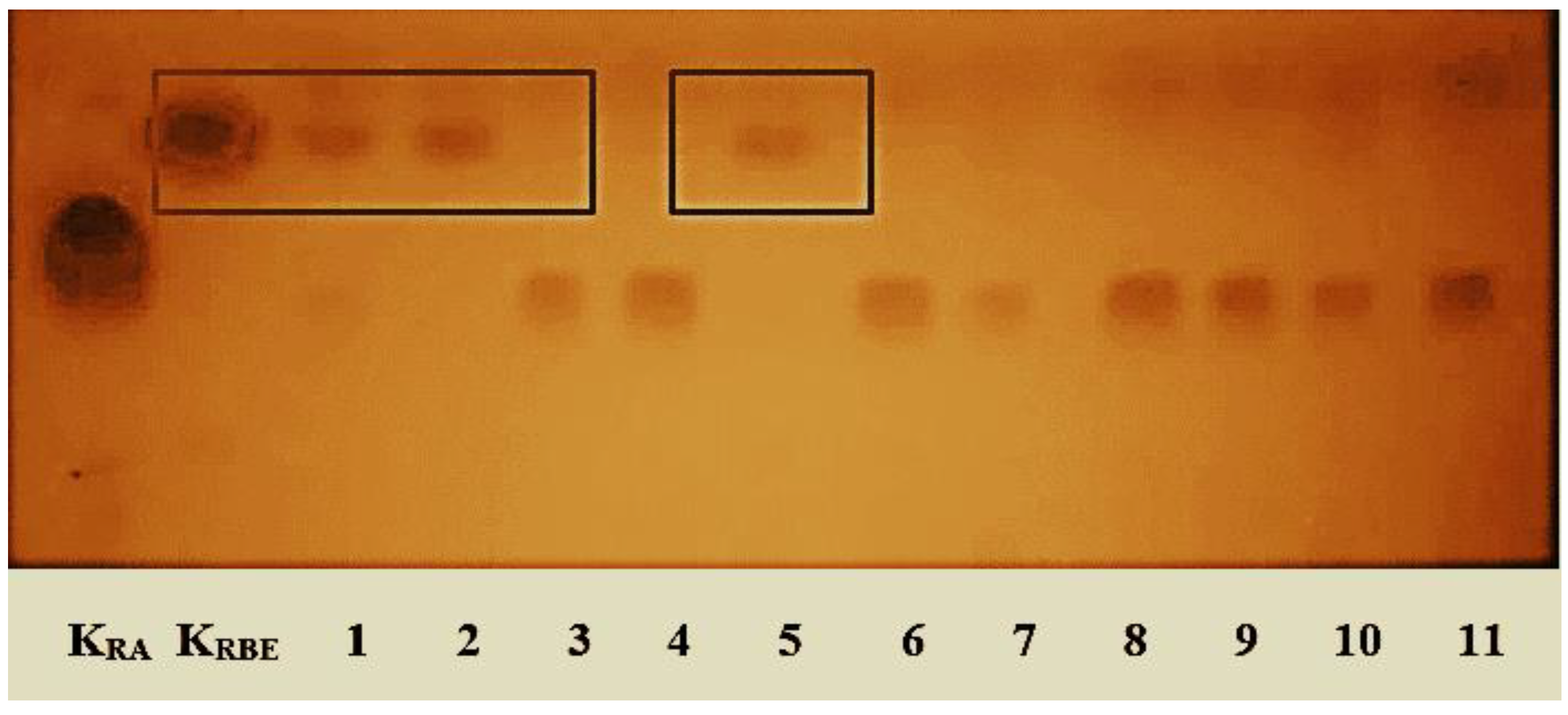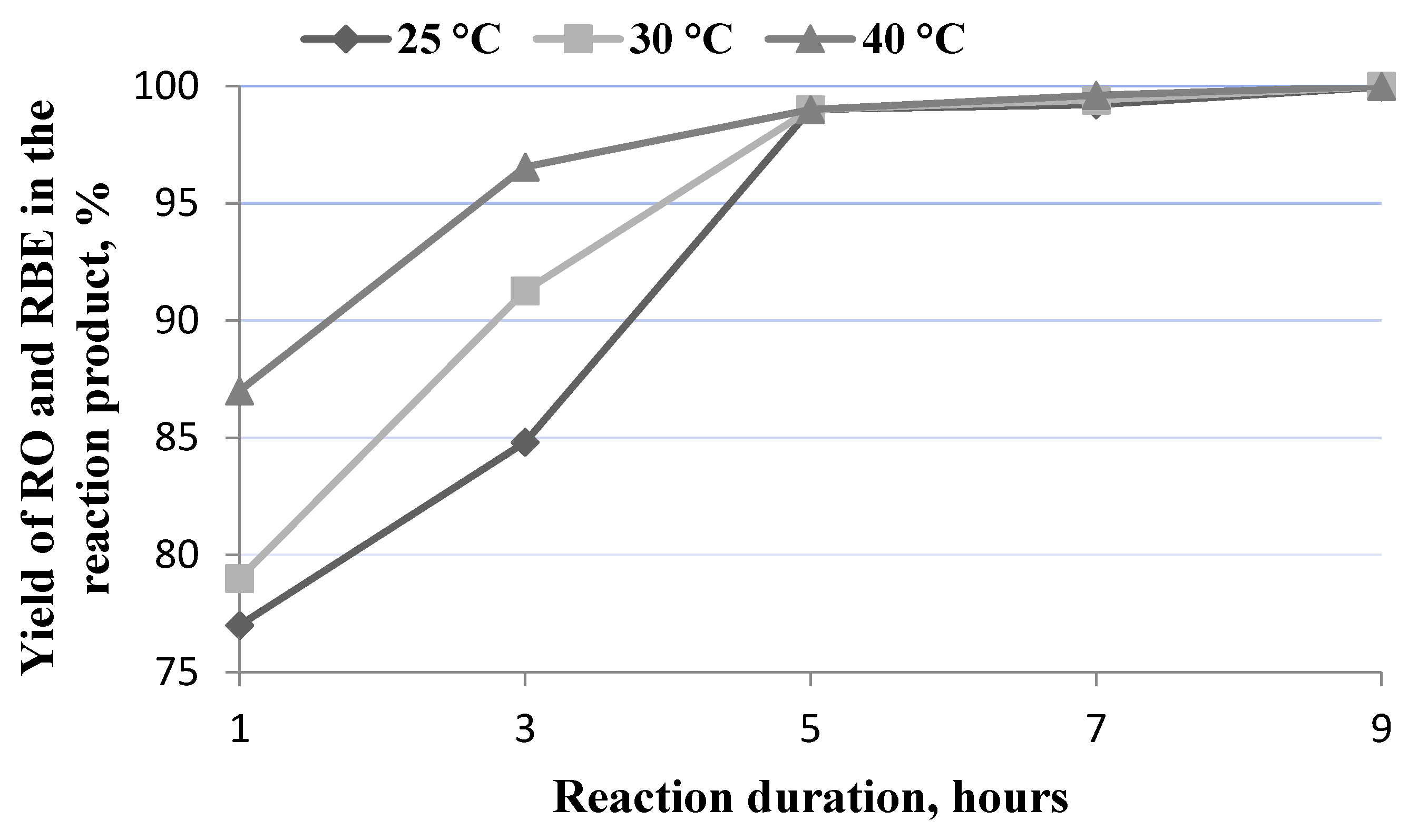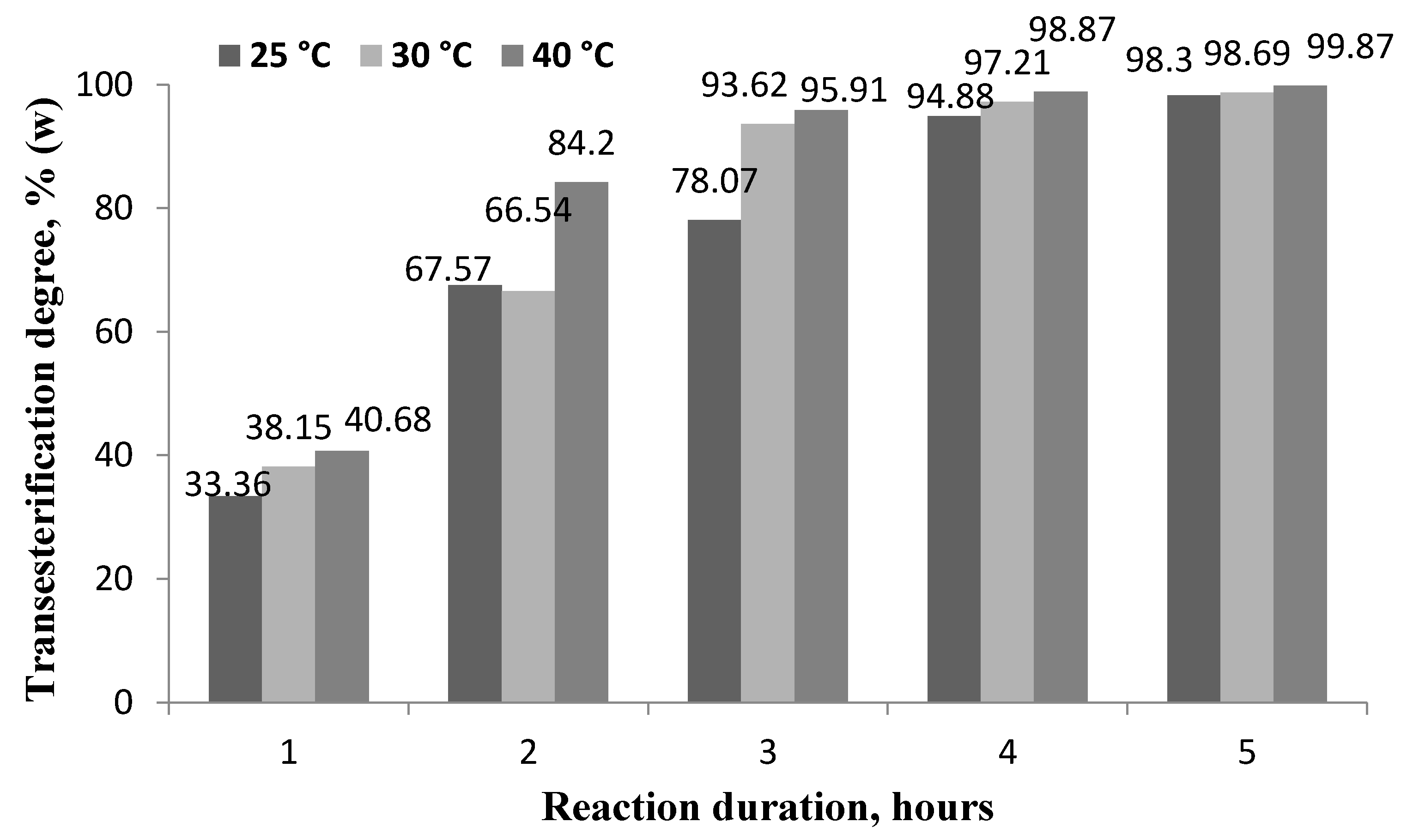Simultaneous Extraction of Rapeseed Oil and Enzymatic Transesterification with Butanol in the Mineral Diesel Medium
Abstract
:1. Introduction
2. Materials and Method
2.1. Materials
- lipases from Candida Antarctica: Novozyme 435 (600 U/g); Lipozyme 435 (600 U/g); Lipozyme CALB (5 kU/g);
- lipases from Thermomyces lanuginosus: Lipozyme TL IM (≥3 kU/g); Lipolase 100L (122 kU/g); Lecitase Ultra (150 U/g); Lipozyme TL 100L (100 kU/g); Lipex 100L (10 kU/g);
- lipases from Rhizomucor miehei: Lipozyme RM IM (>30 U/g); Palatase 20000L (≥20 kU/g);
- lipase from Aspergillus oryzae—Resinase A 2X (119.6 kU/g).
2.2. Quality Assessment of Raw Material and Its Oil
2.3. Selection of Lipase for In Situ Transesterification Process
2.4. Optimization of the Lipase-Catalysed In Situ Transesterification
2.5. Determination of the Rapeseed Oil Extraction Effectiveness and Ester Yield in the Reaction Product
2.6. Determination of Transesterification Degree
2.7. Determination of Physical and Chemical Properties of Fuel Blend
3. Results and Discussions
3.1. Quality of Rapeseed and Their Oil
3.2. Efficacy of Lipases in In Situ Synthesis
3.3. Optimal Conditions of Enzymatic In Situ Process
3.3.1. Effectiveness of Simultaneous Oil Extraction and Transesterification
3.3.2. Optimal Transesterification Temperature and Duration
3.3.3. Optimal Amount of Lipase
3.4. Quality Indicators of Fuel Blends
4. Conclusions
Author Contributions
Funding
Data Availability Statement
Acknowledgments
Conflicts of Interest
References
- U.S. Department of Energy. Biodiesel Handling and Use Guide, 8th ed.; U.S. Department of Energy: Washington, DC, USA, 2020.
- Alexander, D.; Schwandt, H. The Impact of Car Pollution on Infant and Child Health: Evidence from Emissions Cheating; CEPR Discussion Paper No. DP13805; IZA Institute of Labor Economics: Bonn, Germany, 2019. [Google Scholar]
- Karmakar, B.; Halder, G. Progress and future of biodiesel synthesis: Advancements in oil extraction and conversion technologies. Energy Convers. Manag. 2019, 182, 307–339. [Google Scholar] [CrossRef]
- Sarno, M.; Iuliano, M. Biodiesel production from waste cooking oil. Green Process. Synth. 2019, 8, 828–836. [Google Scholar] [CrossRef]
- Lei, H.; Ding, X.; Zhang, H.; Chen, X.; Li, Y.; Zhang, H.; Wang, Z. In situ production of fatty acid methyl ester from low quality rice bran: An economical route for biodiesel production. Fuel 2010, 89, 1475–1479. [Google Scholar] [CrossRef]
- Zeng, J.; Wang, X.; Zhao, B.; Sun, J.; Wang, Y. Rapid In Situ Transesterification of Sunflower Oil. Ind. Eng. Chem. Res. 2009, 48, 850–856. [Google Scholar] [CrossRef]
- Makareviciene, V.; Sendzikiene, E.; Gumbyte, M. Application of Simultaneous Oil Extraction and Transesterification in Biodiesel Fuel Synthesis: A Review. Energies 2020, 13, 2204. [Google Scholar] [CrossRef]
- Ambat, I.; Srivastava, V.; Sillanpää, M. Recent advancement in biodiesel production methodologies using various feedstock: A review. Renew. Sustain. Energy Rev. 2018, 90, 356–369. [Google Scholar] [CrossRef]
- Makareviciene, V.; Sinkuniene, D.; Sendzikiene, E. Optimisation of enzymatic transesterification of linseed oil and pork lard mixture with ethanol using response surface methodology. J. Renew. Sustain. Energy 2015, 7, 053119. [Google Scholar] [CrossRef]
- Makareviciene, V.; Gumbyte, M.; Yunik, A.; Kalenska, S.; Kalenskii, V.; Rachmetov, D.; Sendzikiene, E. Opportunities for the use of chufa sedge in biodiesel production. Ind. Crops Prod. 2013, 50, 633–637. [Google Scholar] [CrossRef]
- Kostić, M.D.; Bazargan, A.; Stamenković, O.S.; Veljković, V.B.; McKay, G. Optimization and kinetics of sunflower oil methanolysis catalyzed by calcium oxide-based catalyst derived from palm kernel shell biochar. Fuel 2016, 163, 304–313. [Google Scholar] [CrossRef]
- Kwiecien, J.; Hájek, M.; Skopal, F. The effect of the acidity of rapeseed oil on its transesterification. Bioresour. Technol. 2009, 100, 5555–5559. [Google Scholar] [CrossRef] [Green Version]
- Sendzikiene, E.; Sinkuniene, D.; Kazanceva, I.; Kazancev, K. Optimization of low quality rapeseed oil transesterification with butanol by applying the response surface methodology. Renew. Energy 2016, 87, 266–272. [Google Scholar] [CrossRef]
- Shuit, S.H.; Lee, K.T.; Kamaruddin, A.H.; Yusup, S. Reactive extraction and in situ esterification of Jatropha curcas L. seeds for the production of biodiesel. Fuel 2010, 89, 527–530. [Google Scholar] [CrossRef]
- Shuit, S.H.; Lee, K.T.; Kamaruddin, A.H.; Yusup, S. Reactive extraction of Jatropha curcas L. seed for production of biodiesel: Process optimization study. Environ. Sci. Technol. 2010, 44, 4361–4367. [Google Scholar] [CrossRef] [PubMed]
- Tran, D.T.; Yeh, K.L.; Chen, C.L.; Chang, J.S. Enzymatic transesterification ofmicroalgal oil from Chlorella vulgaris ESP-31 for biodiesel synthesis using immobilized Burkholderia lipase. Bioresour. Technol. 2012, 108, 119–127. [Google Scholar] [CrossRef]
- Sendzikiene, E.; Makareviciene, V.; Gumbyte, M. Reactive extraction and fermental transesterification of rapeseed oil with butanol in diesel fuel media. Fuel Process. Technol. 2015, 138, 758–764. [Google Scholar] [CrossRef]
- Kojima, S.; Du, D.; Sato, M.; Park, E.Y. Efficient production of fatty acid methyl ester from waste activated bleaching earth using diesel oil as organic solvent. J. Biosci. Bioeng. 2004, 98, 420–424. [Google Scholar] [CrossRef]
- Santaraite, M.; Sendzikiene, E.; Makareviciene, V.; Kazancev, K. Biodiesel Production by Lipase-Catalyzed in Situ Transesterification of Rapeseed Oil Containing a High Free Fatty Acid Content with Ethanol in Diesel Fuel Media. Energies 2020, 13, 2588. [Google Scholar] [CrossRef]
- Sendzikiene, E.; Santaraite, M.; Makareviciene, V. Lipase-Catalysed In Situ Transesterification of Waste Rapeseed Oil to Produce Diesel-Biodiesel Blends. Processes 2020, 8, 1118. [Google Scholar] [CrossRef]
- Abbadi, A.; Leckband, G. Rapeseed breeding for oil content, quality, and sustainability. Eur. J. Lipid Sci. Technol. 2011, 113, 1198–1206. [Google Scholar] [CrossRef]
- Thliveros, P.; Uçkun Kiran, E.; Webb, C. Microbial biodiesel production by direct methanolysis of oleaginous biomass. Bioresour. Technol. 2014, 157, 181–187. [Google Scholar] [CrossRef]
- Hernández-Martín, E.; Otero, C. Different enzyme requirements for the synthesis of biodiesel: Novozym® 435 and Lipozyme® TL IM. Bioresour. Technol. 2008, 99, 277–286. [Google Scholar] [CrossRef] [PubMed]
- Shamel, M.M.; Hasan, M.; Ramachandran, B. Operational stability of lipase enzyme: Effect of temperature and shear. Asia Pac. J. Chem. Eng. 2005, 13, 599–604. [Google Scholar] [CrossRef]
- Haas, J.; Piazza, G.J.; Foglia, T.A. Enzymatic approaches to the production of biodiesel fuels. Lipid Biotechnol. 2002, 29, 587–598. [Google Scholar]
- Antczak, S.M.; Kubiak, A.; Antczak, T.; Bielecki, S. Enzymatic biodiesel synthesis—Key factors affecting efficiency of the process. Renew. Energy 2009, 34, 1185–1194. [Google Scholar] [CrossRef]
- Makareviciene, V.; Gumbyte, M.; Sendzikiene, E. Simultaneous extraction of microalgae Ankistrodesmus sp. oil and enzymatic transesterification with ethanol in the mineral diesel medium. Food Bioprod. Process. 2019, 116, 89–97. [Google Scholar] [CrossRef]
- Foroun, R.; Esmaeili, H.; Mousavi, S.M.L.; Hashemi, S.A.; Yeganeh, G. The Physical Properties of Biodiesel-Diesel Fuel Produced via Transesterification Process from Different Oil Sources. Phys. Chem. Res. 2019, 7, 415–424. [Google Scholar]



| Processes and Stages of Biodiesel Production | Conventional Process of Biodiesel Production | In Situ Biodiesel Production Process |
|---|---|---|
| Processing of raw materials | Crushing of seed | Crushing of seed |
| Pressing/extraction of oil | Extraction of oil | Extraction of oil (optional) |
| Raw oil | ||
| Purification of oil (optional) | Refined oil | |
| Transesterification of oil | Raw biodiesel, glycerol and catalyst (in the case of heterogeneous catalysis) | Raw biodiesel, glycerol and catalyst (in the case of heterogeneous catalysis). By-product—oilseed meal (in the case of oilseed usage) |
| Purification of products | Biodiesel, glycerol | Biodiesel, glycerol by-products. |
| Lipase | Degree of Transesterification, % (w/w) | Glyceride Content in Biodiesel, % (w/w) | ||
|---|---|---|---|---|
| Monoglycerides | Diglycerides | Triglycerides | ||
| Lipozyme RM IM | 87.78 ± 0.06 | 2.38 ± 0.04 | 5.16 ± 0.08 | 6.21 ± 0.05 |
| Lipozyme TL IM | 95.83 ± 0.10 | 1.30 ± 0.02 | 0.37 ± 0.04 | 0.29 ± 0.02 |
| Lipolase 100L | 91.59 ± 0.09 | 1.32 ± 0.02 | 1.00 ± 0.03 | 0.52 ± 0.04 |
| Reaction Time, h | Reaction Temperature, °C | Glycerides Content in Biodiesel, % (w/w) | ||
|---|---|---|---|---|
| Monoglycerides | Diglycerides | Triglycerides | ||
| 1 | 25 | 4.85 ± 0.06 | 3.60 ± 0.03 | 50.44 ± 0.08 |
| 30 | 4.69 ± 0.06 | 3.40 ± 0.04 | 46.26 ± 0.07 | |
| 40 | 5.45 ± 0.05 | 4.12 ± 0.03 | 40.80 ± 0.07 | |
| 3 | 25 | 9.25 ± 0.05 | 3.15 ± 0.04 | 5.50 ± 0.05 |
| 30 | 9.17 ± 0.06 | 3.76 ± 0.04 | 5.88 ± 0.05 | |
| 40 | 3.22 ± 0.03 | 3.61 ± 0.04 | 2.94 ± 0.03 | |
| 5 | 25 | 2.93 ± 0.03 | 5.77 ± 0.06 | 6.84 ± 0.05 |
| 30 | 1.37 ± 0.02 | 1.75 ± 0.04 | 0.59 ± 0.03 | |
| 40 | 1.32 ± 0.02 | 0.40 ± 0.04 | 0.30 ± 0.02 | |
| 7 | 25 | 1.28 ± 0.02 | 1.02 ± 0.04 | 0.57 ± 0.03 |
| 30 | 0.83 ± 0.01 | 0.37 ± 0.02 | 0.24 ± 0.02 | |
| 40 | 0.01 ± 0.00 | 0.03 ± 0.01 | 0.00 ± 0.00 | |
| 9 | 25 | 0.50 ± 0.03 | 0.13 ± 0.03 | 0.31 ± 0.02 |
| 30 | 0.46 ± 0.02 | 0.08 ± 0.02 | 0.08 ± 0.01 | |
| 40 | 0.41 ± 0.02 | 0.04 ± 0.01 | 0.07 ± 0.01 | |
| Amount of Lipase, % | Rapeseed Oil and Rapeseed Oil Butyl Esters Yield, % | Transesterification Degree, % (w/w) | Monoglycerides, % | Diglycerides, % | Triglycerides, % |
|---|---|---|---|---|---|
| 3 | 98.81 ± 0.11 | 92.61 ± 0.14 | 1.25 ± 0.04 | 2.80 ± 0.05 | 1.76 ± 0.05 |
| 4 | 99.31 ± 0.15 | 93.78 ± 0.15 | 0.41 ± 0.03 | 3.09 ± 0.06 | 0.64 ± 0.04 |
| 5 | 99.87 ± 0.08 | 98.18 ± 0.07 | 0.13 ± 0.02 | 0.25 ± 0.03 | 0.19 ± 0.02 |
| 6 | 99.92 ± 0.04 | 99.08 ± 0.08 | 0.03 ± 0.01 | 0.09 ± 0.01 | 0.09 ± 0.01 |
| Fuel Blends | EN 590 | EN 14214 | Mineral Diesel-Rapeseed Butyl Esters 90:10 | Mineral Diesel-Rapeseed Methyl Esters 90:10 [20] | Mineral Diesel-Rapeseed Ethyls Esters 90:10 [19] | |
|---|---|---|---|---|---|---|
| Quality Indicator | Unit | |||||
| Esters | % (mass) | - | Min 96.5 | 99.08 | 98.75 | 99.89 |
| Density at 15 °C | kg m−3 | 820–845 | 860–900 | 831 | 821 | 819 |
| Viscosity at 40 °C | mm2 s−1 | 2–4.5 | 3.5–5 | 2.33 | 2.17 | 2.11 |
| Flash point | °C | Min 55 | Min120 | 73 | 78 | 78 |
| Sulfur | mg kg−1 | Max 10 | Max 10 | 0 | 0 | 0 |
| Copper strip corrosion (3 h at 50 °C) | Degree of corrosion | First degree | First degree | First degree | First degree | First degree |
| Oxidation stability at 110 °C | Hours | Min 20 | Min 8 | 12.84 | 17.87 | 7.49 |
| Cold filter plugging point (in winter) | °C | −32 | −32 | −33 | −36 | −37 |
| Monoglyceride | % (mass) | - | Max 0.8 | 0.03 | 0.46 | 0.00 |
| Diglyceride | % (mass) | - | Max 0.2 | 0.09 | 0.07 | 0.08 |
| Triglyceride | % (mass) | - | Max 0.2 | 0.09 | 0.00 | 0.00 |
| Free glycerol | % (mass) | - | Max 0.2 | 0.00 | 0.00 | 0.00 |
Publisher’s Note: MDPI stays neutral with regard to jurisdictional claims in published maps and institutional affiliations. |
© 2022 by the authors. Licensee MDPI, Basel, Switzerland. This article is an open access article distributed under the terms and conditions of the Creative Commons Attribution (CC BY) license (https://creativecommons.org/licenses/by/4.0/).
Share and Cite
Sendzikiene, E.; Makareviciene, V.; Santaraite, M. Simultaneous Extraction of Rapeseed Oil and Enzymatic Transesterification with Butanol in the Mineral Diesel Medium. Energies 2022, 15, 6837. https://doi.org/10.3390/en15186837
Sendzikiene E, Makareviciene V, Santaraite M. Simultaneous Extraction of Rapeseed Oil and Enzymatic Transesterification with Butanol in the Mineral Diesel Medium. Energies. 2022; 15(18):6837. https://doi.org/10.3390/en15186837
Chicago/Turabian StyleSendzikiene, Egle, Violeta Makareviciene, and Migle Santaraite. 2022. "Simultaneous Extraction of Rapeseed Oil and Enzymatic Transesterification with Butanol in the Mineral Diesel Medium" Energies 15, no. 18: 6837. https://doi.org/10.3390/en15186837








